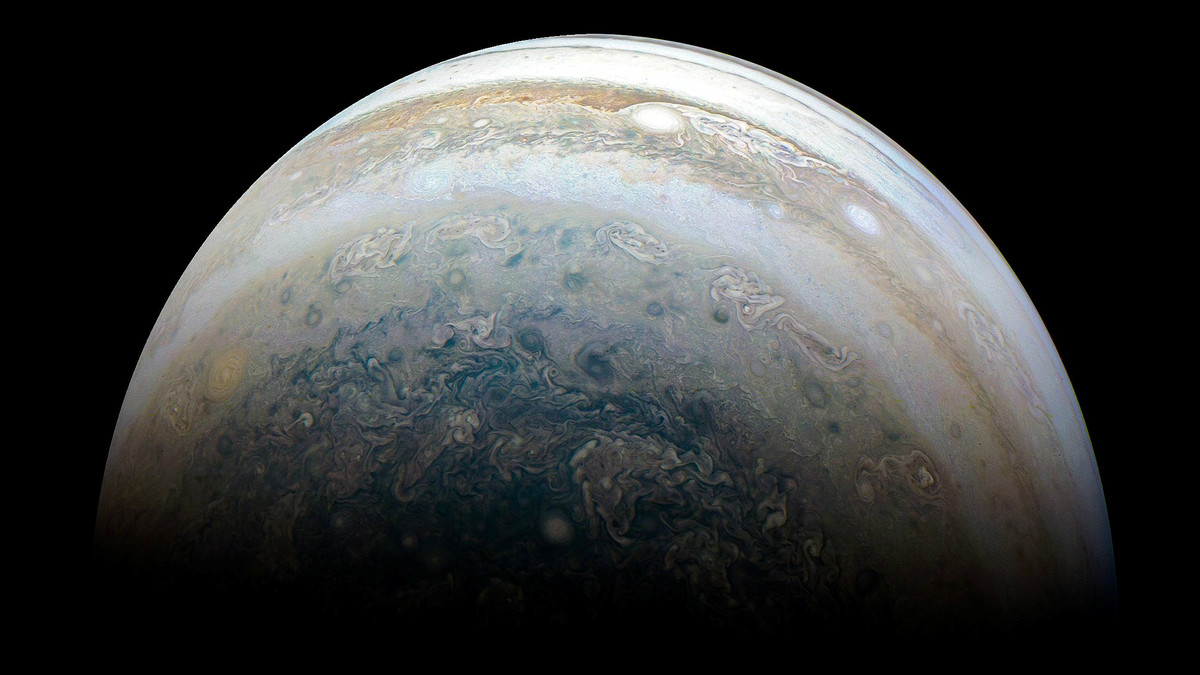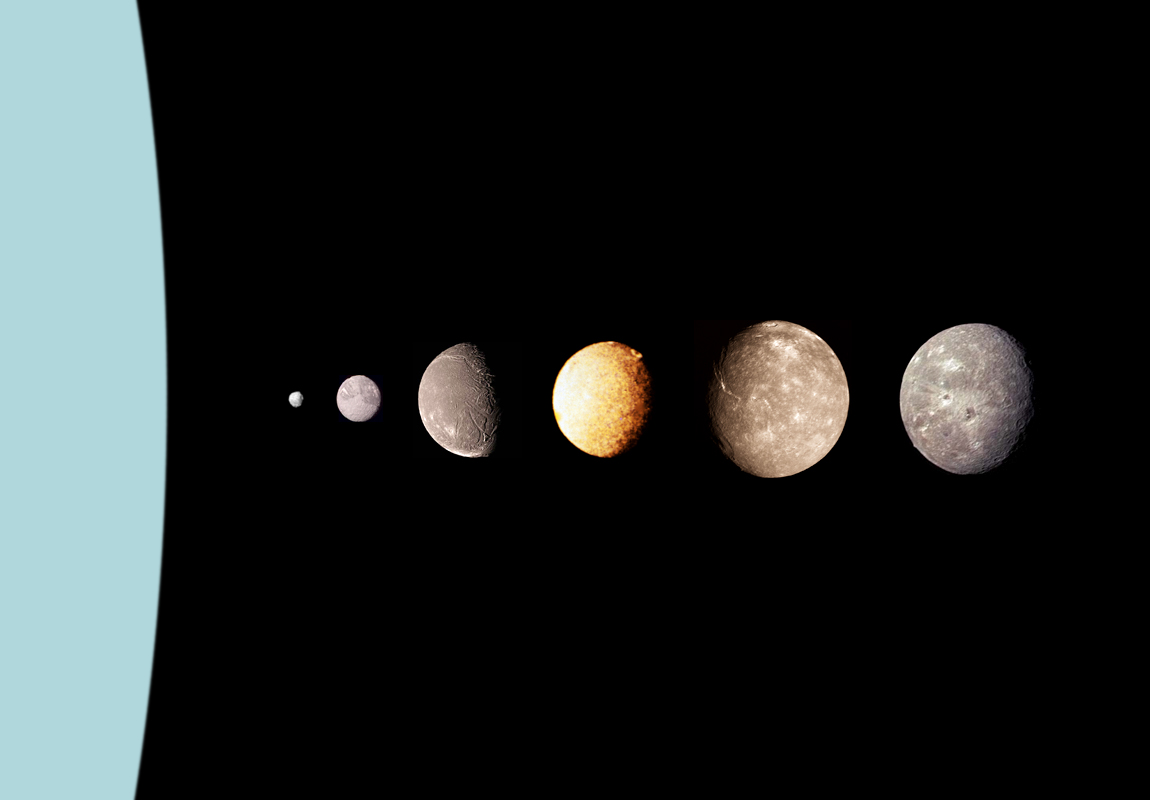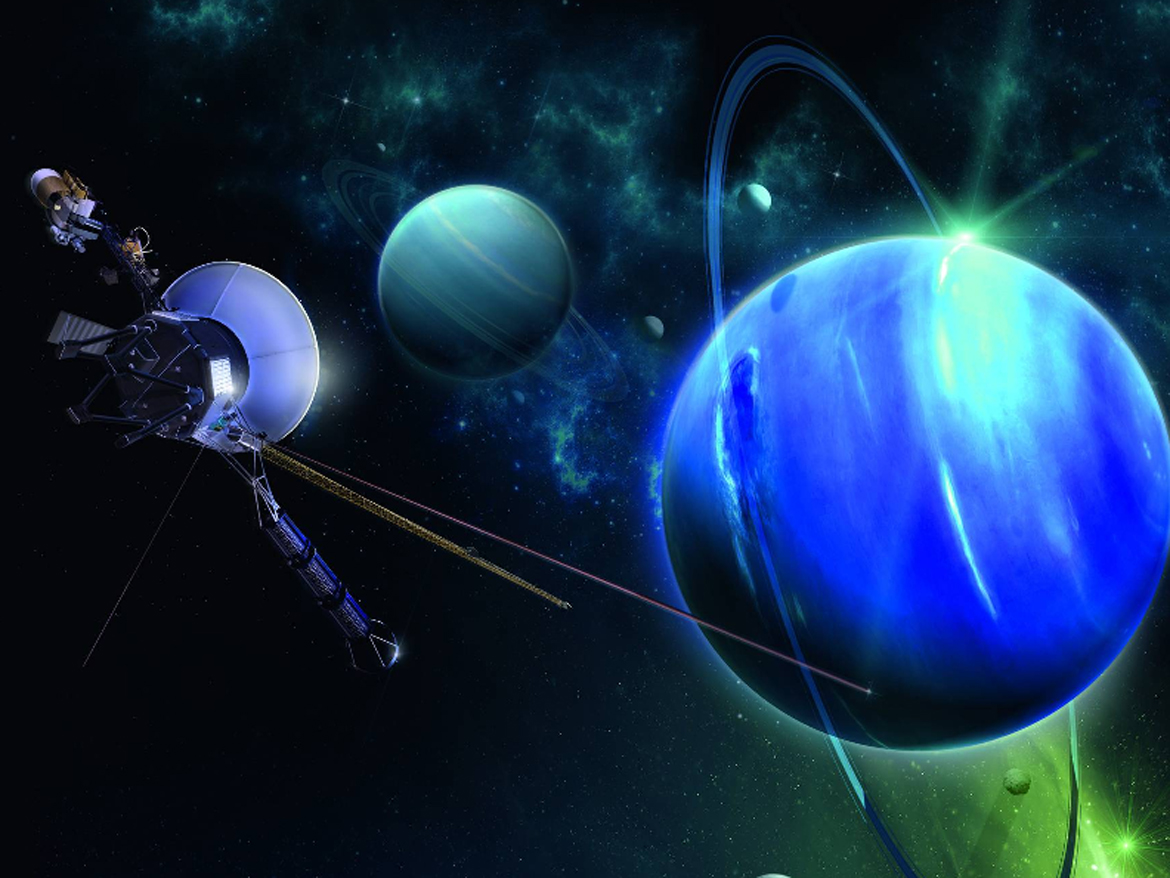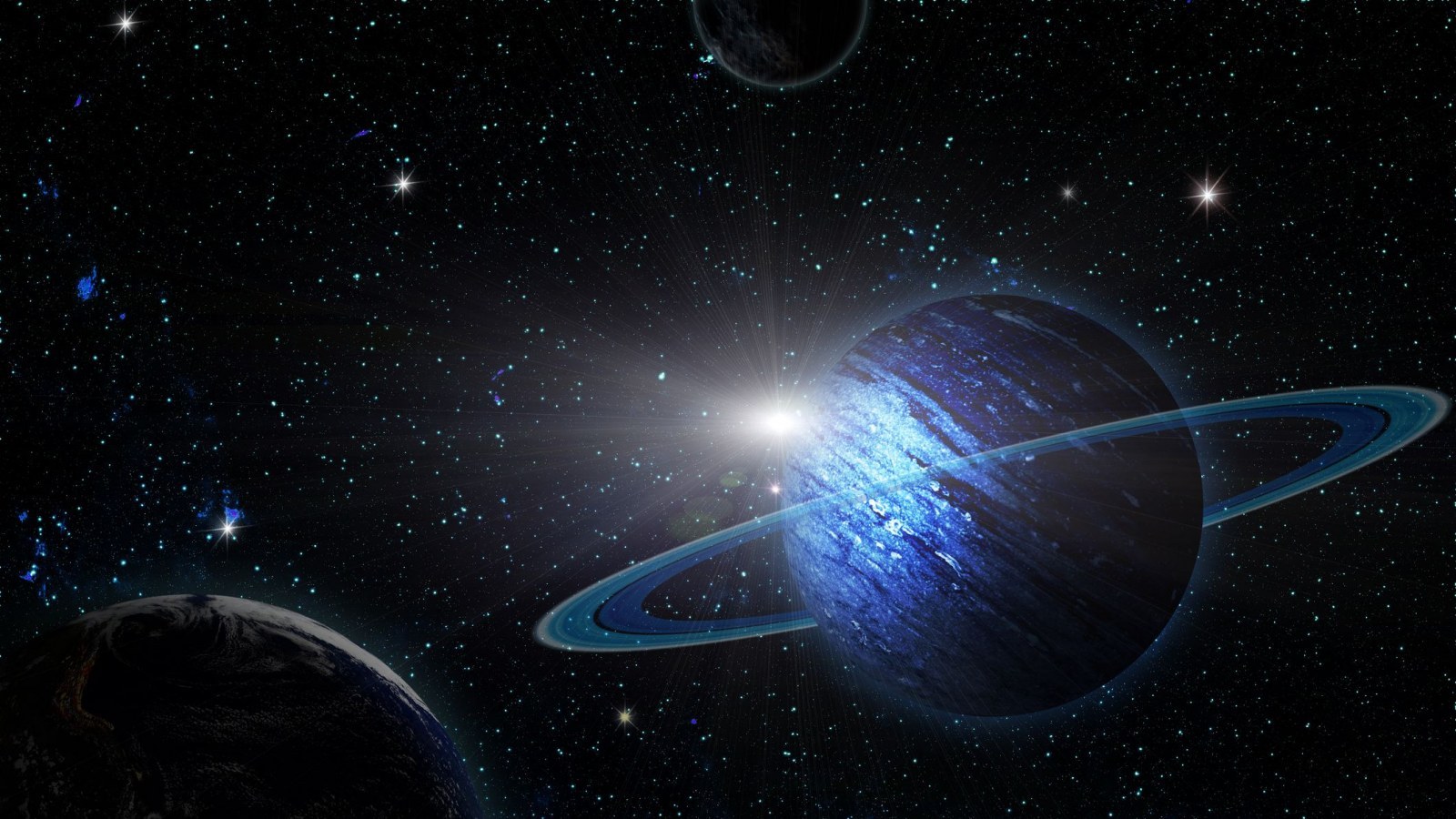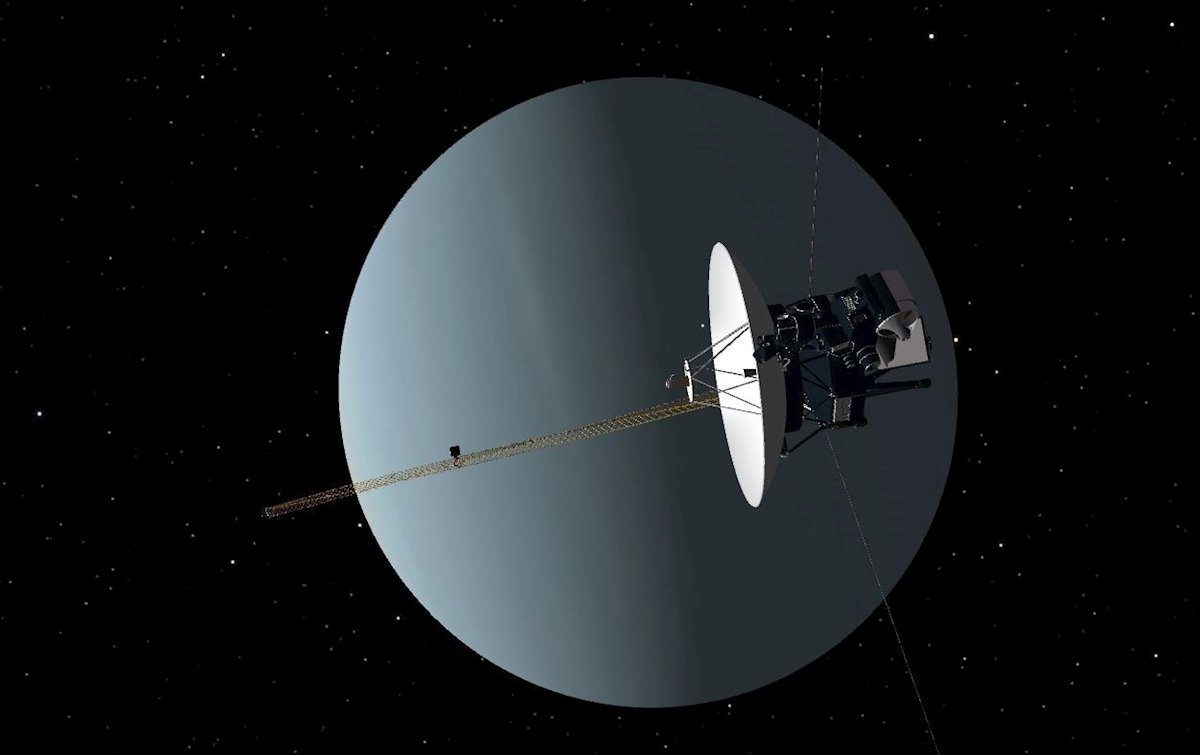Uranus is the seventh planet that orbits the Sun, it cannot be visible with the naked eye, and it became the first planet discovered with the use of a telescope, in this article we teach you all about the Characteristics of Uranus.

Uranus has a very unique and quite surprising meteorology considering that it moves in a very distant orbit, where little light and heat arrives from the Sun, this makes Uranus extremely cold and its average temperature is below -200 degrees Celsius, In the same way, that does not prevent a great wealth of phenomena in its atmosphere.
Its axis of rotation is practically in the plane of its orbit, while the axis of the planets is almost perpendicular or at least strongly tilted compared to this plane, this inclination of the axis of rotation of Uranus leads to what are the poles, the coldest regions are located at latitudes that correspond on Earth to the tropics and the pole plunged into darkness even manages to be slightly warmer than the pole exposed to the Sun.
Characteristics of the planet Uranus
Uranus has its own characteristic, the equator of the planet is very tilted with respect to the plane of the orbit, so much so that its rotation appears, like that of the Planet venus, retrograde. Uranus has about twenty satellites and unlike the other bodies in the Solar System that have names taken from classical mythology.
Among the most relevant features of the Uranus planet
- Uranus is known as the third largest planet in the solar system and the fourth largest in terms of mass.
- It is the coldest planet in the solar system with a minimum temperature of -224°C.
- The average radius of Uranus is 25 ± 362 kilometers, or about 7 Earth radii.
- The surface of Uranus is 8.1156 billion square kilometers.
- The average density of Uranus is 1.27 grams per cubic centimeter.
- The acceleration due to gravity on Uranus is 8.87 meters per second squared (0.886 g).
- Voyager 2 discovered a specific magnetic field on Uranus that is 1/3 of the planet's radius displaced from its geometric center and tilted 59 relative to the axis of rotation.
Other physical characteristics
- Mass: 8.69 * 1025 kg (14 times the size of the Earth)
- Diameter at the equator: 51118 km (4 times the size of the Earth)
- Diameter at pole: 49 km
- Shaft tilt: 98°
- Temperature of the upper layers: approximately –220 ° C
- Period of revolution around the axis (day): 17 hours 15 minutes
- Distance from the Sun (average): 19 ae or 2.87 billion k
- Period of revolution around the Sun in orbit (year): 84.5 years
- Rotation speed in orbit: 6.8 km / s
- Orbit eccentricity: e = 0.044
- Inclination of orbit to ecliptic: i = 0.773°
- Free fall acceleration: about 9 m/s²
- Satellites: there are 27 pieces.
Modular
According to satellite observations, an ironstone core with a temperature of about 7000 K is present in Uranus, but no rivers or oceans are observed, the absence of metallic hydrogen reduces the amount of heat generated by the planet to 30%, so Uranus receives 70% of the thermal energy of the Sun.
Behind the core, a very dense atmosphere immediately begins, with a thickness of about 8 thousand km, the chemical composition of the atmosphere of Uranus is as follows:
- 83% hydrogen (H2),
- 15% helium (He)
- 2% methane (CH4).
Methane, like hydrogen, actively participates in the absorption of solar radiation and therefore of the infrared and red spectra, this explains the blue-green color of the planet, winds in the middle layers, moving at a speed of 250m / yes
Uranus is a unique planet in the solar system, the tilt of the axis of rotation is about 98 degrees, which means that the planet is almost full of garbage on one side, for clarity, if all the planets are like a spinning whirlwind , so Uranus is more like a bowling ball.
Due to such an unusual situation, the change of day, night and seasons on the planet, proceed, to put it mildly, non-standard, it turns out that for 42 years one pole is in the dark, the sun shines on the other, and then change, scientists explain such a strange position of the planet, a collision with another celestial body, which occurred millions of years ago.
Atmosphere
Uranus it needs a stable and well-defined area inside, however, the outermost part of the planet surrounded by vapors viable to remote sensing is known as the atmosphere, the location capacity is developed up to about 300 kilometers, with a proportionate pressure of 100 bars and a temperature of 47 ° C.
Its atmosphere is mainly consisting of molecular hydrogen:
- Helio
- Methane
- Ammonia
- Water
- Hydrogen sulfide
- various hydrocarbons
- Water steam
- Carbon monoxide
- Carbon dioxide
Possibly due to an external source such as falling dust and comets.
Its atmosphere can be divided into three layers:
Troposphere: Between altitudes of -300 and 50 km, with pressures of 100 to 0.1 bar, it is the lowest and densest part of the atmosphere, the temperature decreases with altitude.
Stratosphere: It covers altitudes between 50 and 4.000 km, with pressures between 0.1 and 10 −10 bar, the temperatures increase gradually with the altitude of 53 K.
Thermosphere: Extending from 4,000 km to 50,000 km, it is the outermost layer of the atmosphere and the corona, with a uniform temperature of around 800 to 850 K.
orbit of uranus
Uranus orbits the Sun at an average distance of 2.875 billion km, ranging from 2.742 billion km at perihelion to 3.000 billion km at aphelion, another way of looking at it would be to say that it orbits the Sun at an average distance of 19.2184 AU, more than 19 times the distance between the Earth and the Sun.
The difference between its minimum and maximum distance from the Sun is 269.3 million km, which is the steepest of any of the solar planets, with the possible exception of Pluto and with an average orbital speed of 6.8 km, Uranus has an orbital period equal to 84.0205 Earth years, this means that a single year on Uranus lasts up to 30,688.5 Earth days.
However, since it takes Uranus 17 hours 14 minutes 24 seconds to rotate once on its axis and because of its immense distance from the Sun, a single solar day on Uranus is about the same, this means that a single year on Uranus lasts 42.718 solar days of Uranus and like Venus, Uranus rotates in the opposite direction of its orbit around the Sun, a phenomenon known as retrograde rotation.
moons of uranus
Uranus has 27 known moons, rather than being named after figures from Greek or Roman mythology, its first four moons are named after magical spirits in English literature, such as William Shakespeare's "A Midsummer Night's Dream" and Alexander Pope's "The Abduction of the Lock", since then, astronomers have continued this tradition, drawing names for the moons from the works of Shakespeare or Pope.
William Lassell, is a leading scientist and the first to observe a moon in orbit around Neptune, revealed the next two moons of Uranus, Ariel and Umbriel, it was almost a century before the Dutch-American astronomer Gerard Kuiper, found Miranda in the year 1948.
In the year 1986, Voyager 2 visited the uranium system and discovered ten additional moons, all from 26 to 154 km in diameter:
- Julieta
- Puck
- Cordelia
- Ofelia
- Bianca
- Desdemona
- Portia
- Rosalind
- Cressida
- Belinda
All of Uranus's moons are made of ice and rock each divided in half, meaning that researchers using Hubble and ground-based observatories have grown the total to twenty-seven distinguished moons and are only 12 to 16 km across. wide, black in color and almost 4.8 billion km away.
In addition to the moons, Uranus may have a collection of Trojan asteroids, objects that share the same orbit as the planet, in a special region known as the Lagrange point, the first of which was discovered in 2013, despite claims that the point Lagrange of the planet would be too unstable to host such bodies.
exploration of uranus
Uranus among the classical planets is the only one that is in the plane of its equator is inclined to the plane of the orbit at an angle of 98 degrees, therefore the planet rotates around one axis as if lying on its side.
As a result of this, Uranus faces the Sun alternately from the north pole, then from the south, then from the equator, then from the middle latitudes and also the duration of day and night on it significantly exceeds the axial period of rotation of the planet, at a latitude of 30 degrees, day and night last 14 years, at a latitude of 60 degrees - for 28 years, and at the poles - for 42 years.
The direction of rotation of the planet is opposite to the direction of revolution around the Sun, that is, the opposite, the theoretical model of the structure of Uranus is as follows, its surface layer is a gas-liquid layer, below which there is an ice sheet, a mixture of water and ammonia ice, and even deeper, a core of hard rock.
Like other giant planets, the atmosphere of Uranus consists mainly of hydrogen, helium and methane, the planet has a faintly pronounced ring system, consisting of particles with a diameter of several millimeters to ten meters.
Uranus is surrounded by a system of satellites, whose orbits almost all coincide with the equator plane of the planet, the satellites of Uranus do not move in the plane of their Orbit, as it happens with the satellites of all the other planets, but are almost perpendicular to it, until the year 1986, only five satellites of the planet were known.
The exploration of Uranus is difficult due to its remoteness, new data about the planet and its satellite system made it possible to obtain a relatively close lapse of the American space probe Voyager 2, carried out on January 24, 1986, Voyager-2 was the first and so far the only spacecraft that managed to get as close as possible to Uranus.
During Voyager 2's trip to Uranus, scientists and engineers had to resolve a number of problems associated with operating the station's onboard equipment, which was twice as large as projected from the command post.
The onboard computers have been completely reprogrammed. One of them was tasked with compressing video signals to reduce transmission time to Earth, to receive an extremely weak Voyager 2 radio signal, various antennas from a network of radio stations. deep space tracking were electronically combined into a so-called array to improve their reception power.
The spacecraft crossed the orbit of Uranus along the flight path, most of the information about the planet was obtained in a few hours, while Voyager 2 was nearby, flying at a distance of 81.5 thousand kilometers from the surface of the clouds.
Cameras mounted on a rotating platform constantly surveyed the planet and the satellites, rotating automatically according to a predetermined schedule. Due to the great distance from the Sun, Uranus receives very little sunlight, so the survey was conducted with extremely low exposure. long to capture images of the planet and its satellites.
For such a shot, the station rotated with the camera with an open shutter after the planet, like a cameraman directing a panorama of a fast-moving object.
10 fun facts about Uranus
Uranus is packed with interesting and surprising details, from its many moons, to its ring system and the composition of its aquatic atmosphere, here are just ten things about this gas and ice giant.
- It is the coldest planet: Cloud top temperatures on Uranus average -197.2 degrees Celsius, but can drop as low as -226 degrees Celsius, this is due to the fact that, unlike the other large planets in the Solar System, Uranus actually emits less heat that it absorbs from the Sun.
While the other large planets have tremendously hot cores, which radiate infrared radiation, Uranus' core has cooled to the point that it no longer radiates much energy.
- Orbit the Sun sideways: The axial movement of Uranus is ninety-nine degrees, this means that the planet is rolling on its side, all the planets have the same resemblance to that of a top at the moment that it is rotating around the Sun, but Uranus has more similar to a ball that rolls in a circular pattern and this is another rare phenomenon on Uranus.
- A season lasts a long day: A starry day in Uranus It lasts only about 17 hours, but Uranus's tilt is so steep that one pole or the other usually points toward the Sun. This means that a day at Uranus's north pole lasts half a uranium year, 84 Earth years.
So if you could stand on the north pole of Uranus you would see the Sun rise in the sky and go around for 42 years, at the end of this long drawn out summer the Sun would finally sink below the horizon, this would be followed by 42 years of darkness, also known as a single winter season on Uranus.
- The second least dense planet: With an average density of 1.27 g / cm 3Uranus has the second lowest density of any planet in the Solar System, this low density has an interesting side effect.
- Has rings: Uranus is the second most dramatic set of rings in the Solar System, these rings are composed of extremely dark particles that range in size from micrometers to a fraction of a meter, which is why they are not as visible as those of the Planet Saturn.
- Uranus' atmosphere contains ice: The most interesting thing is the presence of certain "ices" in the atmosphere of Uranus, the third most exuberant device in the atmosphere of Uranus is methane, which is what explains the aquamarine color of Uranus.
- It has 27 moons: Currently, astronomers have confirmed the existence of 27 natural satellites, but for the most part, these moons are small and irregular.
- It was the first planet discovered in the modern era: Uranus was the first planet revealed after the creation of the telescope, it was filmed for the first time in the year 1690 by John Flamsteed, who thought it was a star in the constellation of Tauri.
- You can see Uranus with the naked eye: Uranus has been seen many times in the past by ancient and pre-modern astronomers, but given its low luminosity compared to the other planets, it is often mistaken for a star.
- It has only been visited once: NASA's Voyager 2 made its closest approach to Uranus on January 24, 1986, passing within 81,000 km of the cloud tops of Uranus, no other spacecraft has ever been sent towards Uranus and there are currently no plans to send plus.


